Foxconn Blood Rage - If Looks Could Kill (UPDATE)
by Rajinder Gill on January 2, 2009 6:00 AM EST- Posted in
- Motherboards
It's All About Brawn... Well, Maybe
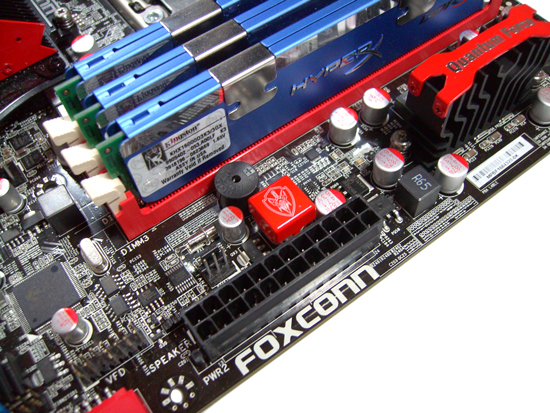 If your CPU and parts are anything like ours, you'll soon find that this "Force Reset" button is your new best friend. |
We're not sure if our situation is unique, but that statement above relates to the fact that all three of our boards refuse to cold or stop-cycle-boot without pressing the "Force Reset" button. Once the board is running, we can apply changes to BCLK reference clocks as long as we don't change major parameters such as clock multipliers. Foxconn's manual states that use of this button resets the system and tunes the board to perform optimally with your components. We think it's primary use is related to boot up memory module read/write leveling performed by the IMC to sense module density/capacitive loads and apply clock/data skew table algorithms and/or a simple reset of all IRQ assignments. This is something that usually happens during the black screen period of the boot cycle on other boards.
As an override, the idea is sound as those of us who push components find ourselves frequently going through complete power cycles to bring boards back to boot. For us though, our boards refuse to function properly without it. Regardless of stock speeds, moderate overclocks, or the more out-on-a-limb stuff, we need to press this button every time to get the board to fire up from a change to a related BIOS function. In order to overcome this we tried PSU swaps and five brands of memory using various ICs and attendant SPDs. A BIOS update should easily fix this problem if the boot cycle configuration is moved back into automated hands. We've alerted Foxconn to this and hope to hear back from them soon. If you happen to stumble across a combination of parts that results in this scenario, you'll need to keep the side panel off your PC case. However, if you run your motherboards out of a case -- as most benchmarking fanatics do -- this probably won't bother you.
Let's press on and get down to the maximum stable speeds we achieved. First up, we have a PCMark Vantage full suite pass at 4.1GHz.
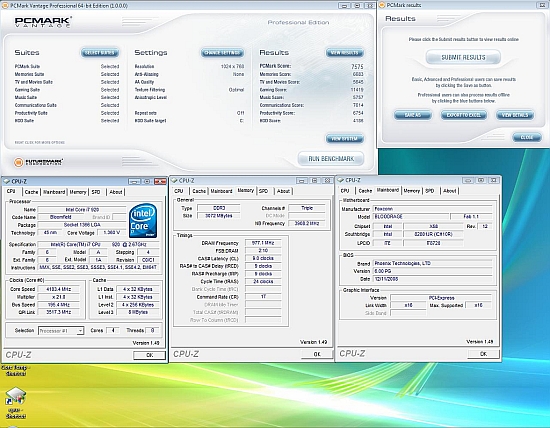 |
This overclock is right on the limits of our water-cooled setup for 24/7 use. 100% processor load temps are in the region of 75C, about as far as we'd expect the processor to remain stable and over the sensible mark for many. VTT/Uncore voltage is critical and needs a sizable boost over stock to around 1.52V for Vantage to pass a full test suite loop on our retail i920 processor.
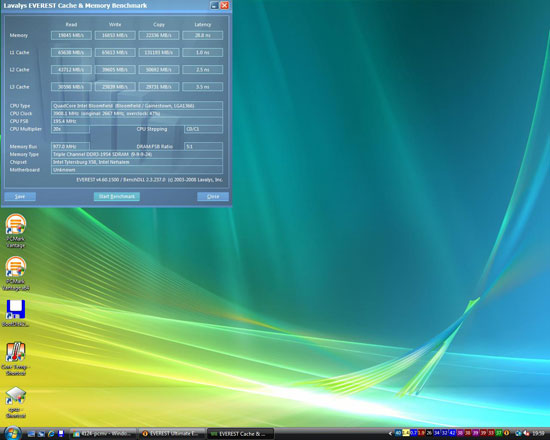 |
Everest Bandwidth on the Nehalem platform is beyond reproach using triple channel memory. In truth, there's little benefit running past 1600MHz, but we thought we'd try it as the Blood Rage virtually demands it. (This and the fact that the Kingston kit is specified to run 2000MHz at 1.65V). On a side note, longer eight thread enabled Prime95 runs were destined to fail unless we increased the Uncore voltage to around 1.54-1.56V. Using a lower memory divider ratio decreases the level of Uncore Voltage required; using the 2:8 divider resulted in a fully stable pass at 1.47V. The required level of Uncore voltage is largely processor dependant, though board design does come into play as we have noticed on the DFI and ASUS boards. With a good CPU, you may get away with less voltage.
Dropping the BCLK reference to 190MHz brings the required level of Uncore voltage down to 1.45V while running the 2:10 memory ratio at 1915MHz 1T in triple channel configuration. This passes a 1 hour OCCT run, multiple loops of PCMark Vantage, and several games with ease.
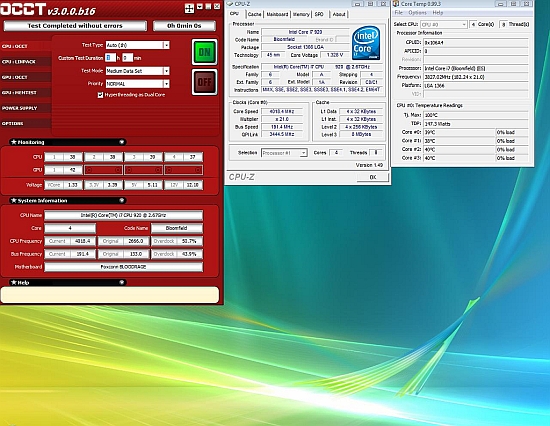 |
We included our test BIOS settings below for those that want to set up the board quickly before tuning it. However, there's not really much to it on this platform, other than the golden rule of keeping VTT/Uncore voltage within ~0.5V of VDDQ (VDIMM). Until we discuss additional secrets of Nehalem overclocking in the coming i7 Guide, it's a game of setting four or five key voltages and letting the BIOS do the rest. One other note to remember is to set the Uncore frequency to a minimum of 2X the memory multiplier. Failure to do so will result in a non-boot in all manual setting situations.
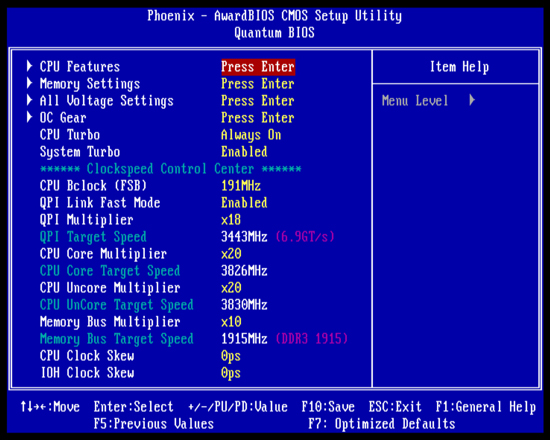 |
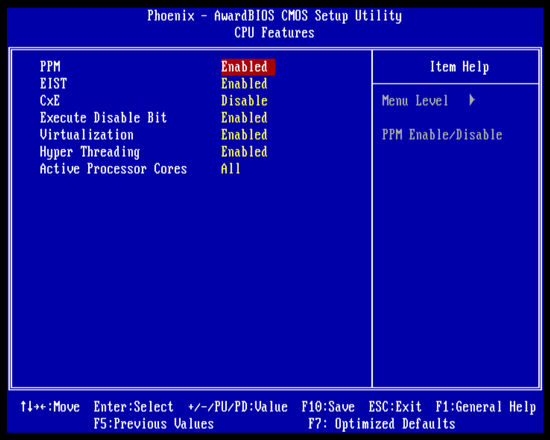 |
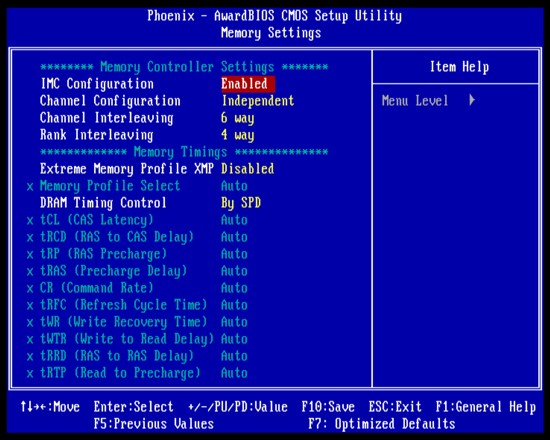 |
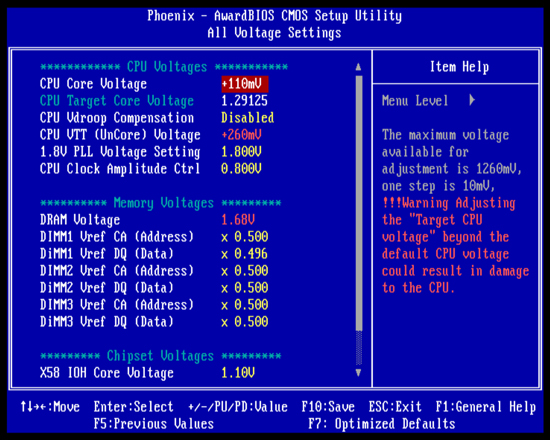 |
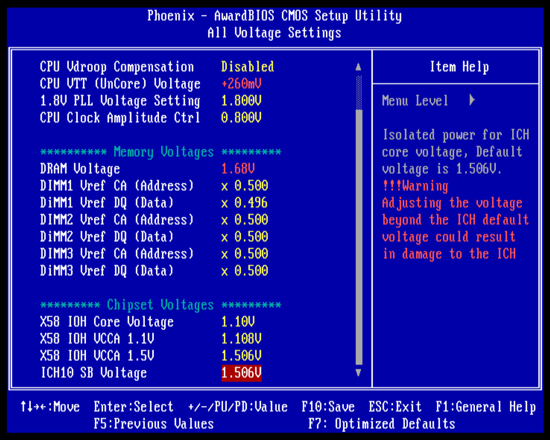 |
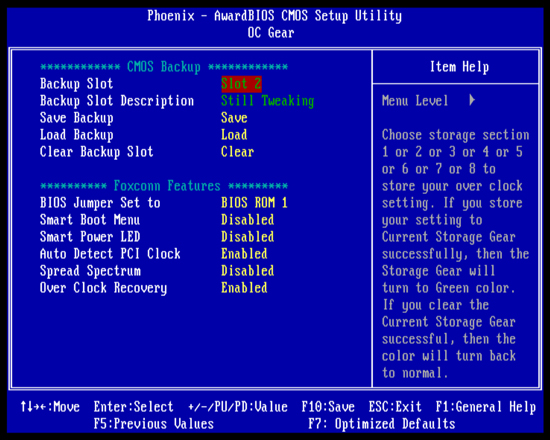 |
On the voltages screenshot you will notice that DIMM1 DQ Ref voltage is set to 0.496X. We found this situation manifests itself whenever we ran our Kingston or G.Skill DDR3-2000 memory in a triple channel configuration. All things being ideal, these values should retain as close to 50% of VDDQ (VDIMM) as possible, unless overshoot and ringback signal effects are affecting the DATA DQ sampling window excessively (which can and does happen at higher bus frequencies).
There is a massive 62 step scale available for each of the ref voltage levels; however DIMM1 remains locked to 0.496V regardless of what you select in BIOS. We tried multiple times to reset this value to 0.50X but found the board would reset to 0.496X after boot every time. We're not sure if this is a "red-button artifact" or if this is a BIOS bug at this point. We are leaning towards a BIOS bug, as a manual user setting should work properly. If it is a bug, then a change as small as this is in the wrong direction is enough to result in an incorrect logic interpretation at very high memory speeds. We have alerted Foxconn to this and await a response.










66 Comments
View All Comments
strikeback03 - Monday, January 5, 2009 - link
Being "brand centric" is being a fanboi if you don't even consider other competing brands. The motherboard gods did not reach down and bless abit, Asus, Gigabyte, etc, with good reliable motherboards; they are the result of good decisions in design and support from the companies. These companies do produce the occasional problem product, and there is nothing stopping them from deciding to cut costs and ride their reputation for a while while producing substandard merchandise (see: Sony). At the same time ECS, Foxconn, etc could decide to dedicate the resources to produce good boards and support themselves, and in time they would have a good reputation. Every product needs to be judged on its own merits, not just the company reputation.As far as this board goes, the layout should make it obvious that this is not really a general-purpose board, but a benchmarkers delight. So as Raja mentioned, pressing the reset button isn't a huge deal if the board isn't in a case. The data is there to draw conclusions from based on each reader's needs.
yyrkoon - Tuesday, January 6, 2009 - link
Being brand centric might mean you're a 'fanboi' if you're you. I however have larger issues to consider, such as customers to please, and support.The 'motherboard gods' do bless companies who put a bit of effort into their product, although you could also think of that as the company being thorough. Every company does have problem products I will agree with that, but time after time again, and it is time to call a lemon, a lemon. As for judging a product by its own merits, I could not agree more, that said there are companies whom have already been named who do put out quality products time , and time again. All you have to do is ask any professional, and I bet if you did not know already it would not be hard to figure out. *hint* Asus does not enter the picture.
Also, I could care less if this is an "benchmarking board", for $300 usd it had better work right, and maybe even serve me coffee in the morning. People such as myself are tired of paying a premium for "quality" parts, only to become a paying beta tester. Now, if Foxconn had a reputation for giving good support, this whole conversation would be moot. As it stands, I can go to the competition and get a rock solid board with excellent support if needed for half the price.
Maybe it is time someone started doing reviews on the average every day system board/parts most people would use instead of wasting every ones time reviewing a niche product that obviously is not going to sell well. To add insult to injury, we see these same kind of reviews _all_the_frigging_time_ here, it would be nice to have a change.
Rajinder Gill - Monday, January 5, 2009 - link
Thanks StrikeBack..Updated first page btw with a para at the top - Foxconn appear to have fixed the issue. I'll be checking this out for myself. They had to change 3 SMT resistors on their boards to rectify it. It only affects some of the high power supplies over 1000W, which many of the people who buy boards like these seem to have - although not all of the PSU's appear to have the issue.
Sorry for the inconvienience caused btw..
later
Raja
7Enigma - Monday, January 5, 2009 - link
Thank you as well from me for the update. I was hard on this article earlier in the comments (and still stand by them), but thank you for the update. I can see now why you were not as gung-ho to bash on the mobo (as not everyone was having problems with it), but I still feel the criticism towards the product was warranted.It is a shame that RMA is required and not just a bios fix. I'm hoping they at least pay shipping both ways....
Rajinder Gill - Tuesday, January 6, 2009 - link
That's Ok. You live and learn. It was a mixture of getting something up fast and not having enough feedback that prompted the format. The Bloodrage is quite a niche product so it can take a while to get sufficient feedback from users in the wild before you can really say soemthing is seriously wrong. Even though our PSU's threw curve balls, similar units from users and in labs have not - go figure, (where do you go from there?) Anyway, I'm glad they're on it and have nailed it. My sample board here is a rev. 1.0 btw, I'm not sure if the updated boards have a different rev number yet - I'll ask.WIth the PSU swap it's a completely different board. I'm running through the regular daily testing atm rebooting, overclocking etc and not one problem since making the PSU change.
Again, sorry for the rigmorale folks. Foxconn have been great over the past few days answering everything within minutes mostly. Thank Sascha @ Foxconn support!
regards
Raja
Gasaraki88 - Monday, January 5, 2009 - link
Thanks for the update. =)Rajinder Gill - Monday, January 5, 2009 - link
If any one reading this has an afflicted board/PSU combo;http://www.xtremesystems.org/forums/showpost.php?p...">http://www.xtremesystems.org/forums/showpost.php?p...
later
Raja
yyrkoon - Sunday, January 4, 2009 - link
It is a shame companies like this still litter the market with junk motherboards, and companies such as ABIT who at least once in a while make a few decent boards go out of the business. To be perfectly honest though, I have been using ABIT since the early to mid 90's, and their boards have ALWAYS served me well.I guess I will be moving to Gigabyte, it sure will not be foxconn.
hooflung - Sunday, January 4, 2009 - link
While I won't lay the blame completely at Anandtech's feet I feel these articles are just reader fodder in the sense that any news is good news. Review after review from this site and others the consensus is X-58 motherboards suck. Despite the quality of the components. Despite the quality of the build. Despite the quality of the spec's and engineering of Intel's chipset and cpu... these boards are just plain quirky.If AMD did this we'd have a complete AMD motherboard review that criticized the company left, right and center and point out how good Intel is. Seriously guys... I'd rather read about how good P45 chips are doing and a review of companies who gave the best amount of bios and mobo support throughout the product cycle than late breaking news on how much potential a motherboard could have with a few tweaks.
Also, Foxconn is crap for supporting their motherboards. I have their 780G mini-atx and the NIC died on me after a Vista Realtek 8111B driver update to the point NO OS would install an official realtec, official foxconn or opensource driver even though the chip is seen by all OSs. Foxconn responded for a week to me via email with broken English requests to try xyz that I already did, and explained to them, and then asked ME to contact Microsoft and Realtek to inquire into what might have happened to the Realtek August 2008 Vista 64 driver updates. I mean... ok. Yeah... one guy with a warrantied board asking these companies... or a multi-million dollar partner. Which one is more likely to get a response?
Screw Foxconn... screw all these bloody half-baked Intel X58 mobo reviews and get down to what many people crave. Real company insight in an unbiased fashion. Get back to the basics and quite this techfodder.
InSearchOf - Saturday, January 3, 2009 - link
i have decided on buying a motherboard based on the P45 chipset since for me it offers the best bang for your buck. the dilemma im having is which manufacturer should i put my money in?ASUS, Gigabyte, MSI, DFI etc....
ive also read alot and one should never buy the first versions of mobo and wait for 2nd version after the kinks have been worked out but how long before manuf. put a revised mobo on the market after first release? 3, 6 or 9 months???
what about BIOS updates? how often do these companies update them and how do they treat RMAs and warranties?
can any of you enlighten me with your past experiences and knowledge!
thanks